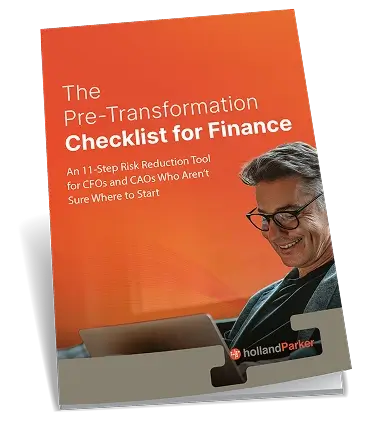Large-scale finance transformations are rarely about technology alone. They are about people, processes, and the ability to drive change at scale in an environment where disruption is constant. HollandParker, a leader in financial transformation, has seen time and again that even the best-designed finance initiatives stall when program leaders overlook the human side of change. To make finance transformation sustainable, leaders must apply proven change ¸management frameworks that reduce resistance, align stakeholders, and deliver measurable outcomes.
Finance leaders know that transformation efforts—whether implementing a new ERP system, redesigning the target operating model, or embedding artificial intelligence—carry high stakes. Research shows that 70% of change programs fail to achieve their goals, largely due to employee resistance and lack of management support. This reality underscores the importance of a deliberate, structured approach to managing change in finance.
This article explores four practical frameworks that program leaders can apply in finance transformations: the ADKAR model, Kotter’s 8-Step Process, stakeholder alignment strategies, and a finance transformation roadmap anchored in behavioral adoption. Each provides a different lens on how to drive buy-in and overcome resistance.
The ADKAR Model: Shaping Individual Adoption
The ADKAR model—developed by Prosci—is one of the most widely applied change management frameworks because it focuses on the individual journey through change. Finance transformations succeed when each employee, from accountants to senior analysts, moves through the stages of Awareness, Desire, Knowledge, Ability, and Reinforcement.
In finance settings, ADKAR is particularly effective because it provides a structured way to address the concerns of employees whose roles are being disrupted by automation or redefined by new reporting structures. For example:
- Awareness: Communicating why a shift to digital finance or AI-enabled processes is necessary.
- Desire: Connecting transformation goals to employees’ daily pain points, such as reducing manual reconciliations.
- Knowledge: Providing training on new financial systems, compliance requirements, or analytics tools.
- Ability: Supporting employees with practice opportunities and coaching during rollout.
- Reinforcement: Recognizing early adopters and embedding performance metrics tied to new behaviors.
HollandParker has observed that when program leaders apply ADKAR consistently, finance teams feel less threatened by change and more engaged in building the future state.
Kotter’s 8-Step Process: Driving Organizational Momentum
While ADKAR emphasizes individual adoption, Kotter’s 8-Step Process provides a roadmap for organizational-level change. In finance transformations, where initiatives affect multiple functions and geographies, Kotter’s model ensures that momentum builds and continues.
The steps—creating urgency, building a guiding coalition, developing a vision, communicating it broadly, empowering employees, generating quick wins, sustaining acceleration, and anchoring changes—resonate strongly in finance. For example, quick wins might include reducing the financial close cycle by 30% within the first quarter of a system implementation, demonstrating immediate value and winning over skeptics.
Kotter’s framework also emphasizes coalition building. For finance, this means bringing together not only CFOs but also controllers, IT leaders, compliance officers, and business unit heads. When these stakeholders align around a common vision, resistance weakens, and accountability strengthens.
Studies show that transformation initiatives that create short-term wins are far more likely to succeed. Finance leaders who structure their roadmaps around Kotter’s process can maintain urgency and prevent fatigue in long, complex programs.
Stakeholder Alignment Strategies: Reducing Resistance at the Source
Stakeholder alignment is the bedrock of successful finance transformation. Finance leaders often face competing priorities: regulators demand compliance, executives seek faster insights, and staff worry about job security. A strong stakeholder alignment strategy addresses these tensions directly.
Effective approaches include:
- Stakeholder mapping: Identifying levels of influence and potential resistance early.
- Tailored communications: Delivering different messages to CFOs, controllers, and staff accountants based on their needs and concerns.
- Feedback loops: Using surveys and town halls to gather input, respond to concerns, and adjust implementation plans.
- Visible sponsorship: Ensuring that executives actively demonstrate commitment, not just approval.
In practice, HollandParker has seen programs falter when finance leaders assumed that a single communication plan would suffice. Instead, tailoring messaging to address the “what’s in it for me?” question at each stakeholder level significantly increases engagement.
A Finance Transformation Roadmap Anchored in Behavioral Adoption
A common pitfall in finance change management is focusing only on milestones—system go-lives, process sign-offs, or compliance deadlines—while neglecting behavioral adoption. A roadmap anchored in behavioral change ensures that the transformation lasts beyond the initial rollout.
Such a roadmap should include:
- Behavioral KPIs: Tracking adoption rates of new systems, timeliness of reporting, and accuracy of automated processes.
- Change champions: Identifying influential staff members to advocate for new ways of working.
- Ongoing reinforcement: Embedding adoption metrics into performance reviews and recognition programs.
- Sustainability checks: Conducting post-implementation assessments to ensure behaviors are embedded six, twelve, and eighteen months later.
Companies that embed behavioral change in transformation programs are significantly more likely to sustain benefits over time. Finance leaders who build these checkpoints into their roadmaps reduce the risk of reverting to old practices.
Moving Finance Change from Resistance to Results
Finance transformation is one of the most challenging types of organizational change because it directly affects compliance, reporting, and decision-making processes. Program leaders who apply structured change management frameworks—ADKAR for individual adoption, Kotter’s 8-Step Process for organizational alignment, stakeholder engagement strategies for buy-in, and roadmaps anchored in behavior—create a foundation for lasting success.
Insights from HollandParker’s work with finance leaders show that applying these frameworks reduces resistance, builds trust, and ensures transformation success. With the right structure in place, finance change can move from being a source of disruption to a driver of strategic advantage.
Frequently Asked Questions
Why is change management critical in finance transformation?
Because finance touches compliance, reporting, and enterprise decision-making, ineffective change management can lead to failed implementations, regulatory risk, and financial inaccuracies.
What is the most effective change management framework for finance?
No single framework works for all situations. ADKAR helps at the individual adoption level, while Kotter’s 8-Step model provides a structured path for organizational momentum. Most successful programs use a hybrid approach.
How can finance leaders reduce resistance to change?
Leaders can reduce resistance by communicating early and often, involving employees in the process, aligning messages to stakeholder concerns, and reinforcing new behaviors through recognition and metrics.
How do you measure the success of change management in finance?
Success is measured through both process outcomes and behavioral adoption—faster close cycles, improved reporting accuracy, higher employee engagement, and sustained use of new systems and processes.
What role do executives play in change management?
Executive sponsorship is one of the strongest predictors of success. Leaders must not only endorse initiatives but also model behaviors, engage in communication, and demonstrate accountability throughout the transformation.







